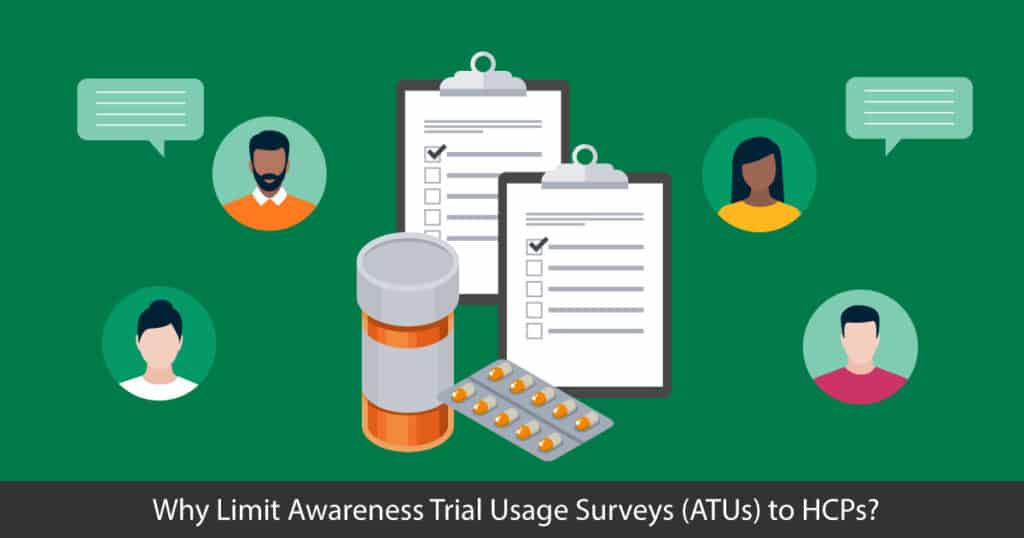Why Limit Awareness Trial Usage Surveys (ATUs) to HCPs? Patients and Caregivers Provide Needed Insights

By Richard Tsai
One online glossary defining ATUs (Awareness, Trial, and Usage studies) described them, in part, as “survey[s] to measure consumer awareness, trial, and product usage for a product category and/or brand…” But in a pharma marketing context, it seems as if the participant in the study is almost always presumed to be the prescriber.
More than one source researched for this article was written with that assumption. For example, an article on current updates on how ATUs are implemented in pharma referred to the studies as conducted on physicians, and gave an example of one performed with 50 oncologists.1 Another described the challenge of keeping the physician’s attention through the survey.2
If you want to assess the impact of a brand the ATU is a good tool; but don’t overlook surveying the awareness, trial, and usage experiences of the patients and caregivers. Patients and caregivers view a brand in the context of their overall journey, a viewpoint that the HCP can’t provide.
As Gordon Olsen (Executive VP, Brand Strategist) and Toby Trygg (Executive Creative Director), both of Ogilvy Health said in a May 2020 article on brand building, patients care about many of the same benefits that concern prescribers. These aspects are traditionally evaluated with an ATU: “Efficacy, safety, trust, etc.” However, Olsen and Trygg point out that- “[patients] also want convenience, easy comparisons with other products, and company accountability.” 2Their article recommends that pharmaceutical companies develop more social media strategies: It’s where today’s patients research treatments.
In social communities like Inspire, patients describe their treatments in terms of duration of use, any side effects, and compare them directly with other treatments they’ve tried. (Recent Inspire blog posts, such as the one on patients discussing Crohn’s and colitis treatments, include similar example quotes.) Empowered patients want more control over their health journey. They often bring what they’ve learned from their peers right to their doctors:
“I was on [one biologic] a for a year and it only helped some am now on [another biologic] was at 8 weeks now 6 weeks and then doubled my dose from 5mg to 10 it is now helping me have a normal life don’t get discouraged yet this was over another year of trial and error.” https://corp.inspire.com/blog/treatment-options-crohns-disease-ulcerative-colitis/
“I’ve been on __drug name__ for two months, now. _physician’s name__ prescribed making the switch from __drug name__back in __month__ and so far so good. Some fatigue and weakness but I am also on a bunch of other meds so who knows. He has me taking it before bedtime and I sleep very well – nice benefit from it. My appetite, etc. has been good. I continue to exercise daily to stay fit and try to ward off fatigue and weakness. You can check my profile to see what I’ve been up to as far as treatment goes – it includes __drug name__per __protocol name__. Second infusion scheduled for today.” ~Inspire Member
Conducting an ATU for pre-launch marketing within a respected health community on social media can reveal what patients and caregivers want in a treatment, supporting the development of engaging and persuasive messaging. An ATU can learn where patients are obtaining information and awareness of your company’s up and coming treatment. For mature brands, the ATU can reveal previously unknown subsets of the market that can be targeted to refresh sales. Pinpointing unmet needs of qualified patients through an ATU can assist in identifying a new value prop for your product. When competitive drugs come on the market, patients on social media with long term positive experiences with an established drug say so, and recommend that others ask their physicians for that medication– keeping the mature drug an active player.
Today we share a case study illustrating the power of data from ATUs of patients and caregivers.
Inspire offers a trusted community to patients and caregivers. Our goal with this blog, this website and our content is to provide the life science industry access to the true, authentic patient voice. In so doing, we support faithful operationalization of patient-centricity. Take a look at our case studies, eBooks and news outlet coverage.
References
1Oates-Zalesky, M. “Tracking studies: Moving with the times.” Pharmaphorum, March 15, 2017. https://pharmaphorum.com/views-and-analysis/tracking-studies-moving-times/
2Costa, C. “ATUs aren’t enough — it’s time to go automated.” PM360online, May 29, 2018. https://www.pm360online.com/atus-arent-enough-its-time-to-go-automated/






